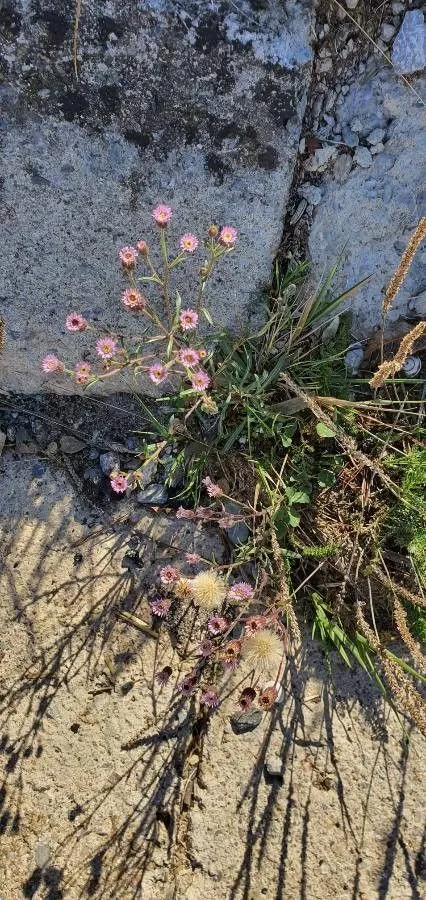
Author: L.
Bibliography: Sp. Pl.: 863 (1753)
Year: 1753
Status: accepted
Rank: species
Genus: Erigeron
Vegetable: False
Observations: Temp. Eurasia to N. Myanmar
Bitter daisy, known scientifically as Erigeron acris, is an intriguing plant belonging to the Asteraceae family. First described by the renowned botanist Carl Linnaeus in 1753 in his seminal work Species Plantarum, Bitter daisy has garnered attention for its distinct presence and wide-ranging habitat.
Flourishing across temperate regions from Eurasia to Northern Myanmar, this resilient plant thrives in a variety of environmental conditions. Erigeron acris is notable for its ability to adapt and persist in diverse climates, making it a common sight across its vast geographical range.
Visually, Bitter daisy is characterized by its charming, yet modest flowers, which embody the typical daisy-like appearance. The plant exhibits small, composite flowers with central yellow disc florets surrounded by delicate, radiating white or pinkish petals. This simple beauty often masks its hardiness and ability to grow in challenging conditions.
In botanical circles, Erigeron acris is appreciated not just for its beauty but also for its role within its ecosystem. It is a common inhabitant of grasslands, meadows, and other open, disturbed sites where it contributes to the floral diversity and provides a food source for various pollinators, including bees and butterflies.
The adaptability and endurance of Bitter daisy reflect its broader ecological importance. While many might overlook this unassuming plant, scientists and horticulturists recognize it as a resilient species capable of thriving where others might not. This robust nature ensures that Erigeron acris will continue to be a familiar plant across its native regions, contributing to the natural beauty and ecological health of these landscapes.
Dan: bitter bakkestjerne
Deu: scharfes berufkraut (i. e. s.), scharfes berufkraut i.w.s.
Nor: bakke-stierne
Nno: bakkestjerne
Nob: bakkestjerne
Eng: bitter daisy, bitter fleabane, blue fleabane, bitter boreal daisy
Swe: gråbinka, karvaskallioinen
Fin: karvaskallioinen
Sme: ránescammu
Fra: vergerette acre
Cym: amrhydlwyd glas, amrhydlwyd rhuddlas, cedowydd glas amrhydlwyd
En: Bitter daisy, Blue fleabane, Bitter fleabane, Bitter boreal daisy
Ar: أريغارون لاذع
Zh: 飞蓬
Cs: Turan ostrý
Da: Bitter Bakkestjerne
Nl: Scherpe fijnstraal
Et: Jaani-õnnehein
Fi: Karvaskallioinen
Fr: Vergerette acre, Vergerette âcre, Érigeron âcre
De: Scharfes Berufkraut, Scharfes Berufkraut (i. e. S.), Scharfes Berufkraut i.w.S., Flohkraut, Rauhes Berufkraut
Hu: Bóbitás küllőrojt
Ga: Lus gorm na ndreancaidí
It: Céspica acre
Lv: Asais jānītis
Se: Ránescammu
No: Bakke-stierne
Nb: Bakkestjerne
Nn: Bakkestjerne
Fa: پیر بهار تلخ
Pl: Przymiotno ostre
Ru: Мелколепестник едкий
Sk: Turica ostrá
Es: Zarramagar
Sv: Gråbinka, Karvaskallioinen
Zh-tw: 飛蓬
Cy: Amrhydlwyd glas, Amrhydlwyd Rhuddlas, Cedowydd Glas Amrhydlwyd
© copyright of the Board of Trustees of the Royal Botanic Gardens, Kew.
© copyright of the Board of Trustees of the Royal Botanic Gardens, Kew.
© copyright of the Board of Trustees of the Royal Botanic Gardens, Kew.
Taken Aug 6, 2021 by Henk Van Lottum (cc-by-sa)
Taken Oct 26, 2021 by Clapés Jordi (cc-by-sa)
Taken Oct 30, 2022 by Darren Giddins (cc-by-sa)
Taken Sep 1, 2020 by jeclerencia (cc-by-sa)
Taken Oct 23, 2021 by César Gonzalez (cc-by-sa)
Taken Oct 24, 2022 by Fabrice Rubio (cc-by-sa)
Taken Feb 11, 2021 by Santiago (cc-by-sa)
Taken Sep 5, 2021 by Emanuele Santarelli (cc-by-sa)
Taken Jul 17, 2021 by Daniel Bourget (cc-by-sa)
Taken Oct 26, 2021 by Clapés Jordi (cc-by-sa)
Taken Jul 21, 2018 by Renaud Brochiero (cc-by-sa)
Taken Nov 7, 2022 by F. Manzano (cc-by-sa)
Taken Nov 19, 2022 by Ivan Yushin (cc-by-sa)
Taken Sep 18, 2013 by parramon marta (cc-by-sa)
Taken Oct 26, 2021 by Clapés Jordi (cc-by-sa)
Taken Oct 29, 2020 by Fernandez Cusachs Marc (cc-by-sa)
Taken Sep 3, 2021 by Pierre LEON (cc-by-sa)
Taken Aug 14, 2017 by Yoan MARTIN (cc-by-sa)
Taken Sep 7, 2022 by Danai Andre (cc-by-sa)
Taken Oct 26, 2021 by Clapés Jordi (cc-by-sa)
Taken Aug 15, 2009 by Photoflora – Benoit BOCK (©)
Taken Aug 13, 2011 by Tela Botanica − Laurent PETIT (cc-by-sa)
Taken Aug 17, 1903 by Tela Botanica − Anne-Marie GRIMAUD (cc-by-sa)
Taken Oct 14, 2015 by Tela Botanica − Dominique REMAUD (cc-by-sa)
Taken Aug 2, 2021 by Pietro Brignoli (cc-by-sa)
Taken Jun 25, 2021 by nicolas pecqueux (cc-by-sa)
Taken Oct 24, 2022 by Fabrice Rubio (cc-by-sa)
Taken Jul 17, 2021 by Daniel Bourget (cc-by-sa)
Taken Sep 5, 2021 by Emanuele Santarelli (cc-by-sa)
Taken Aug 2, 2021 by Pietro Brignoli (cc-by-sa)
Growth form: Stoloniferous
Growth habit: Forb/herb
Growth rate: Moderate
Ph maximum: 8.0
Ph minimum: 7.5
Light: 9
Atmospheric humidity: 5
Soil nutriments: 4
Family: Myrtaceae Author: (F.Muell.) K.D.Hill & L.A.S.Johnson Bibliography: Telopea 6: 402 (1995) Year: 1995 Status:…
Family: Rubiaceae Author: Pierre ex A.Froehner Bibliography: Notizbl. Bot. Gart. Berlin-Dahlem 1: 237 (1897) Year:…
Family: Sapindaceae Author: Koidz. Bibliography: J. Coll. Sci. Imp. Univ. Tokyo 32(1): 38 (1911) Year:…
Family: Asteraceae Author: A.Gray Bibliography: Pacif. Railr. Rep.: 107 (1857) Year: 1857 Status: accepted Rank:…
Family: Fabaceae Author: Medik. Bibliography: Vorles. Churpfälz. Phys.-Ökon. Ges. 2: 398 (1787) Year: 1787 Status:…
Family: Aspleniaceae Author: (Cav.) Alston Bibliography: Bull. Misc. Inform. Kew 1932: 309 (1932) Year: 1932…